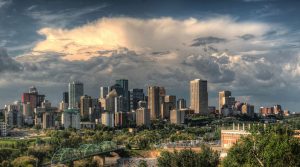Canada’s strength in regenerative medicine (RM) and cell and gene therapies is a result of efforts that take place from sea to shining sea. Western Canada’s growing RM community significantly increases Canada’s competitiveness on the global playing field through its leading-edge research, advanced commercialization abilities, and excellent education and training programs.
Prowess in research
The region’s renowned researchers aim to answer the important questions that will define the future of medicine.
For example, the lab of Dr. Fabio Rossi, in the School of Biomedical Engineering at the University of British Columbia (UBC) in Vancouver, is identifying and characterizing adult tissue specific stem cells to understand how they regulate themselves and neighbouring stem cells, and how such regulation goes awry in diseases.
Also at UBC, the Department of Cellular and & Physiological Sciences is conducting multi-disciplinary research in stem cell therapy and RM with the goal of achieving medical breakthroughs in these fields. One of the department’s Principal Investigators, Dr. Timothy Kieffer, won the 2015 Till & McCulloch Award in recognition of his paper that advanced the knowledge around a treatment for diabetes.
Dr. Stephanie Willerth’s lab, in the Department of Mechanical Engineering at the University of Victoria, is creating novel tools for addressing significant biological problems in tissue engineering and RM. By working with human pluripotent stem cells to engineer functional neural tissue, the lab hopes to develop tissues suitable for transplantation in the human nervous system to treat neurological diseases and other conditions.
And, at the University of Calgary in Alberta, the lab of Dr. Michael Kallos is focused on developing bioprocesses for stem cell expansion and differentiation, specializing in using stirred-suspension bioreactors. The lab’s custom-built 10 mL bioreactors allow for the fast, efficient completion of many experiments, supporting scale-up to larger volumes as a critical step in the commercialization process.
Competitive commercialization capabilities
Recognizing the region’s potential for growth, and the opportunity to add value with expertise in company creation and incubation, it was critical for CCRM to establish an on-the-ground presence in the west, which happened in 2018. Led by Dr. Peter Zandstra, CCRM’s Chief Scientific Officer, CCRM is building connections with western Principal Investigators and start-ups to provide support in commercializing and accelerating their innovative research. Here are some companies to watch.
In 2018, STEMCELL Technologies announced a $45 million joint funding agreement between the Governments of Canada and British Columbia (BC) for a state-of-the-art advanced manufacturing facility. The $138 million, five-year project will build a new BC-based advanced manufacturing facility for biologics.
RepliCel Life Sciences is advancing cell therapy by developing products to rejuvenate aging or sun damaged skin, regrow hair and repair tendons. The Vancouver-based company has recently published Phase I clinical trial data from its skin rejuvenation study.
The west is also home to Aspect Biosystems, which specializes in ground-breaking technologies in 3D bioprinting and tissue engineering. Its vision involves building living human tissues for drug testing to avoid the use of animals and reminds us that RM is laden with awe-inspiring promise.
Launched at the end of 2019, Notch Therapeutics is establishing dual home bases in both Vancouver and Toronto. This company is developing a next-generation pipeline of off-the-shelf, universally-compatible, genetically-tailored T cell therapeutics derived from renewable stem cell sources for the treatment of high-impact diseases, with an initial focus on cancer. Notch is currently building its team and plans to hire 15 people in Vancouver within the next year.
High-performance education
The western ecosystem is being fed with in-demand education and training. Biomedical engineering was named as one of the “most valuable majors” by Forbes, and graduates of these programs are playing key roles in RM.
In addition to being director of the Michael Smith Labs at UBC, Dr. Zandstra is also founding director of the university’s new School of Biomedical Engineering (SBE), mentioned earlier. The SBE combines access to world-leading research infrastructure, and close partnerships with research-intensive hospitals and industry, to provide a route from discovery of new fundamental biomedical technologies to their application and development. Established in 2017, its undergraduate and post-graduate degree programs are accepting students.
The University of Calgary’s Centre for Bioengineering Research and Education (CBRE), in the Schulich School of Engineering, is also advancing knowledge and solving problems in RM. With a few more years under its belt than the SBE, the CBRE is using expertise in stem cell biology, biomaterials and bioprocessing technology to tackle its research focus areas, which include finding novel regenerative medicine solutions for aneurysms, cartilage repair, nerve repair and skin regeneration.
Another institution offering biomedical engineering and RM education is the University of Alberta’s Faculty of Engineering, located in Edmonton. By collaborating with other departments across the school, like Pharmacy, Medicine and Surgery, the faculty’s researchers and students are studying, developing and improving drugs and other medical technologies.
Another good option for a biomedical education is the University of Victoria. It’s Biomedical Engineering Undergraduate program was established in 2011. Learn more about what it has to offer here.
Strength in numbers
Lastly, the BC Regenerative Medicine Cluster Initiative, BCRegMed, is a unifying cluster that stems from the Canada First Research Excellence Fund. It brings together members of BC’s academic community and other stakeholders to capitalize on opportunities, from enabling clinical trials to providing training.
After examining some of the activity taking place in Western Canada, it’s clear that it supports Canada’s position as a heavy-hitter in RM and cell and gene therapies. But, bear in mind that the developments listed above by no means make up an exhaustive list.
Can you think of other developments in Western Canada that are helping to make our country more competitive in RM? Share in the comments.
Laine Bodnar
Latest posts by Laine Bodnar (see all)
- Right Turn: Ethics in science communication - April 8, 2025
- Regulatory affairs careers: What scientists need to know - March 18, 2025
- How to kickstart scicomm careers beyond academia - October 31, 2024








Comments